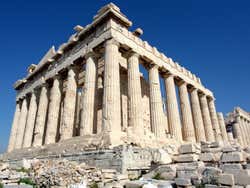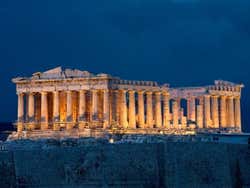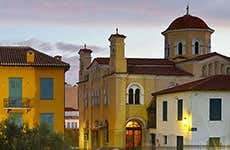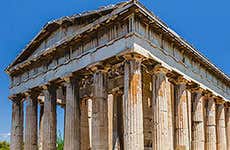
Parthenon
Erected between 447 and 438 BCE on the Acropolis, the Parthenon represents the epitome of Ancient Greece and is the most famous landmark in the country.
Dedicated to the goddess Athena, the Parthenon is one of the most symbolic Doric style temples that remains standing in Greece. It is also one of the most imposing buildings commissioned by Pericles.
Details about the place of worship
The Parthenon was raised on the remains of the sixth century temple Hekatompedon, which was destroyed by the Persians in 480 BC.
After the Hekatompedon was demolished, the Athenians wished to build a larger temple to house a beautiful and enormous 12-meter gold and ivory sculpture of Athena, designed by the sculptor Phidias. So, the Parthenon was constructed in white marble from Mount Pentelicus.
The large temple is 70 meters long and 30 meters wide. When it was first built, it had a colonnade surrounding the whole edifice, with eight columns standing on its main façades and seventeen on each side.
It is believed that the procession to the Parthenon during the Panathenaic Games is sculpted on the inner frieze that runs along the whole temple and shows over 300 people, various gods and animals.
The Parthenon's misfortunes
Throughout the centuries, the Parthenon has been severely damaged. It was transformed into a Byzantine church between 1208 and 1258 and then remodeled into a mosque in 1458.
During the Morean War in 1687 between the Venetians and Ottoman Turks, the center of the temple was destroyed when a compartment for the storage of explosives, owned by the Turks, went off.
Between 1801 and 1803, Thomas Bruce sold the remaining statues and other artefacts to the British Museum in London.
The Parthenon has faced centuries of challenges and calamities, yet its most dramatic blow came in 1894, when one of the strongest earthquakes in Greek history caused significant damage to the iconic structure.
Despite this, the Parthenon remains a symbol of resilience. Today, ongoing conservation and reconstruction efforts aim to restore its grandeur. Visitors will notice cranes and support structures around the site, but these modern interventions do little to diminish the awe-inspiring presence of this ancient masterpiece.
Symbol of Athens and Greece
Although the capital of Greece is overflowing with landmarks and monuments, the Parthenon is the country’s most iconic sight.
Visiting the Parthenon while you explore the Acropolis overlooking Athens is a must and will not leave you indifferent.
Guided tour
If you want to take a guided tour of the Agora and discover the foundations of one of the most influential civilizations in history, you can do it from this link. It also includes a visit to the Acropolis.


Transport
Metro: Monastiraki, lines 1 and 3; Akropoli, line 2.
Nearby places
Acropolis of Athens (31 m) Theatre of Dionysus (151 m) Anafiotika (169 m) Kanellopoulos Museum (174 m) Odeon of Herodes Atticus (212 m)

